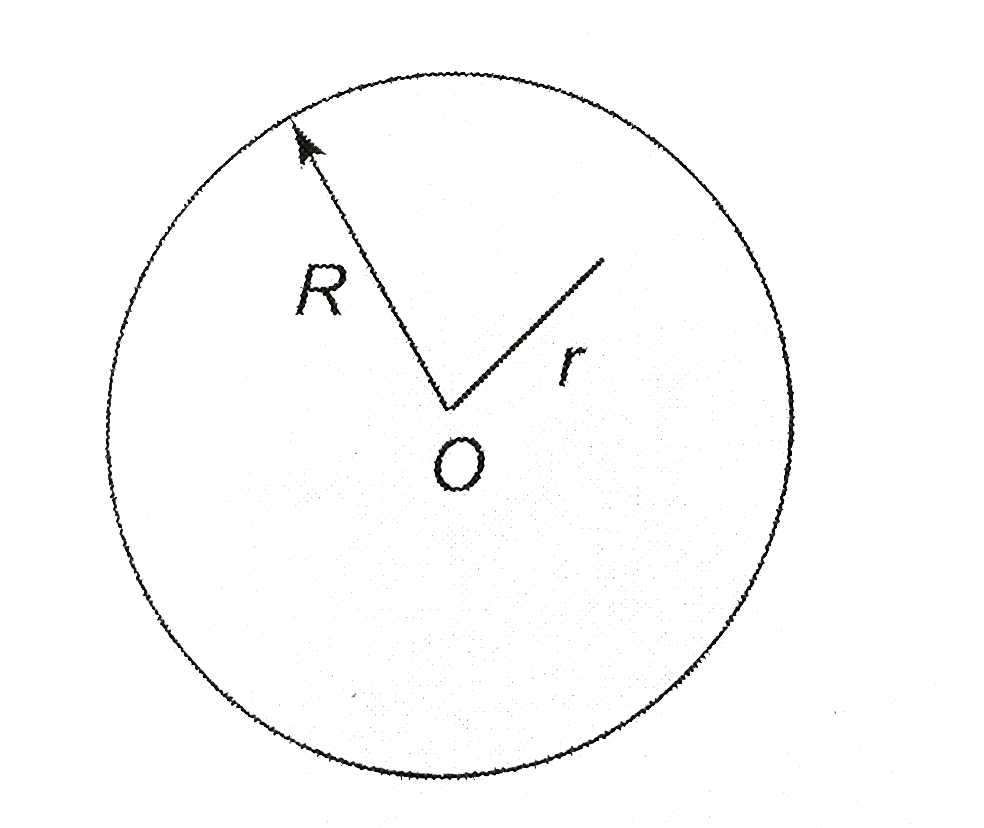A cyclist rides along the circumference of a circular horizontal plane of radius R, with the friction coefficient μ=μ0(1−rR), where μ0 is constant and r is distance from centre of plane O. Find the radius of the circle along which the cyclist can ride with the maximum velocity, what is this valocity?

According to the question, the cyclist moves along the circular path and the centripetal force is provided by the frictional force. Thus from the equation Fn=mwn
fr=mv2r or kmg=mv2l
or k0(1−rR)g=v2r or v2=k0(r−r2/R)g (1)
For vmax, we should have d(r−r2R)dr=0
or, 1−2rR=0, so r=R/2
Hence vmax=12√k0gR
Topper's Solved these Questions
- BOOK - IE IRODOV, LA SENA & SS KROTOVCHAPTER - PHYSICAL FUNDAMENTALS OF MECHANICSEXERCISE - Laws Of Conservation Of Energy, Momentum And Angular Momentum82videos
PHYSICAL FUNDAMENTALS OF MECHANICS
- BOOK - IE IRODOV, LA SENA & SS KROTOVCHAPTER - PHYSICAL FUNDAMENTALS OF MECHANICSEXERCISE - Universal Gravitation34videos
PHYSICAL FUNDAMENTALS OF MECHANICS
- BOOK - IE IRODOV, LA SENA & SS KROTOVCHAPTER - PHYSICAL FUNDAMENTALS OF MECHANICSEXERCISE - Relativistic Mechanics49videos
PHYSICAL FUNDAMENTALS OF MECHANICS
- BOOK - IE IRODOV, LA SENA & SS KROTOVCHAPTER - OSCILLATIONS AND WAVESEXERCISE - Electromagnetic Waves, Radiation36videos
OSCILLATIONS AND WAVES
- BOOK - IE IRODOV, LA SENA & SS KROTOVCHAPTER - THERMODYNAMICS AND MOLECULAR PHYSICSEXERCISE - Transport Phenomena38videos
THERMODYNAMICS AND MOLECULAR PHYSICS
Similar Questions
A cyclist rides along a circular path in a horizontal plane where the coefficient of friction varies with distance from the centre O of the circular path as μ=μ0(1−rR) where R is the maximum distance up to which the road is rough
Find the radius of the circular path along which the cyclist can ride with maximum velocity. What is this maximum velocity ?View SolutionA uniform circular plate of radius 2R has a circular hole of radius R cut out of it. The centre of the smaller circle is at a distance of R/3 from the centre of the larger circle. What is the position of the centre of mass of the plate?
View Solution
Knowledge Check
- Question 1 - Select One
A cyclist rides along the circular path of a circular horizontal plane of radius R, the firctional coefficient being dependent only on distance r from the centre O of the plane as μ=μ0(1−rR), where μ0 is a constant.
Find the radius of the circle such that the cyclist can ride with the maximum velocity.ARBR2CR3DR4 - Question 2 - Select One
A cyclist rides along the circular path of a circular horizontal plane of radius R, the firctional coefficient being dependent only on distance r from the centre O of the plane as μ=μ0(1−rR), where μ0 is a constant.
What is the cyclist's maximum velocity ?A√μRgB2√μ0RgC12√μ0RgD√2μ0Rg - Question 3 - Select One
The maximum speed of a car on a curved path of radius 'r' and the coefficient of friction μk is
Av=√μkgrBv=√μkgrCv=√grμkDv=√1μkgr
A small block starts sliding down an inclined plane subtending an angle θ with the horizontal . The coefficient of friction between the block and plane depends on the distance covered from rest along the plane as μ=μ0x where μ0 is a constant . Find (a) the distance covered by the block down the plane till it stops sliding and (b) its maximum velocity during this journey .
View SolutionA car starts from rest in a circular flat road of radius R with an acceleration a. The friction coefficient between the road and the tyred is μ Find the distance car will travel before is start skidding.
View SolutionThe maximum speed of a car on a curved path of radius 'r' and the coefficient of friction μk is .
View SolutionMass density of sphere of radius R is Kr2. Where K is constant and r is distance from centre. A particle is moving near surface of sphere along circular path of radius R with time period T. Then
View SolutionA car is taking turn on a circular path of radius R. If the coefficient of friction between the tyres and road is μ, the maximum velocity for no slipping is
View Solution

